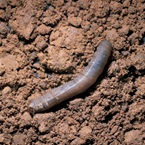// The Problem
Blacklegged ticks (BLT) can carry bacteria that cause Lyme disease, and are a major public health concern. Lyme disease is on the rise in Canada, as these ticks continue to spread into new areas.
Ticks are closely related to spiders. They are typically small when unfed, (1 to 5 mm in length), and all active stages feed on blood. They cannot fly and they move quite slowly. Ticks usually come in contact with people or animals by positioning themselves on tall grass and bushes. They may take several hours to find a suitable place on the host to attach to feed. Most tick bites are painless. The majority of bites will not result in disease because most ticks are not infected with the agent of Lyme disease.
Blacklegged ticks pass through three different life stages (larva-1, nymph-2, adult male-3, adult female-4). The nymphal stage typically occurs during the summer months and is the stage most likely to infect people with Lyme disease. This is due to their small size which prevents people from noticing them on their body.
// Envu Solutions
Turf areas that are of particular importance to observe for ticks include those adjacent to forested areas, stonewalls, ornamental plantings and other areas where there is overgrown vegetation. Reduce tick habitat through landscape management practices including but not limited to mowing the turf and removal of weeds, leaf litter and other debris where ticks are found.
// DeltaGard SC is now Labelled for Control of Ticks
DeltaGard SC, containing the active ingredient deltamethrin, is a broad-spectrum pyrethroid insecticide registered for control of ticks, ants, chinch bugs, cutworm and sod webworm on turfgrass. Use DeltaGard SC in conjunction with a comprehensive management program that includes modifying the landscape habitat around the home to help minimize harbourage areas for ticks. Treat with DeltaGard SC in a three metre band to turf areas around property lines or around structures such as dog houses, kennels, sidewalks, pathways or patios to help protect against ticks around the home.
Application Rate: 12 mL/100 m2 Water Volume: 8L/100 m2
*Description of ticks is taken from the Ontario Ministry of Health and LongTerm Care fact sheet: http://www.health.gov.on.ca/en/public/publications/disease/lyme.aspx
// Resources



